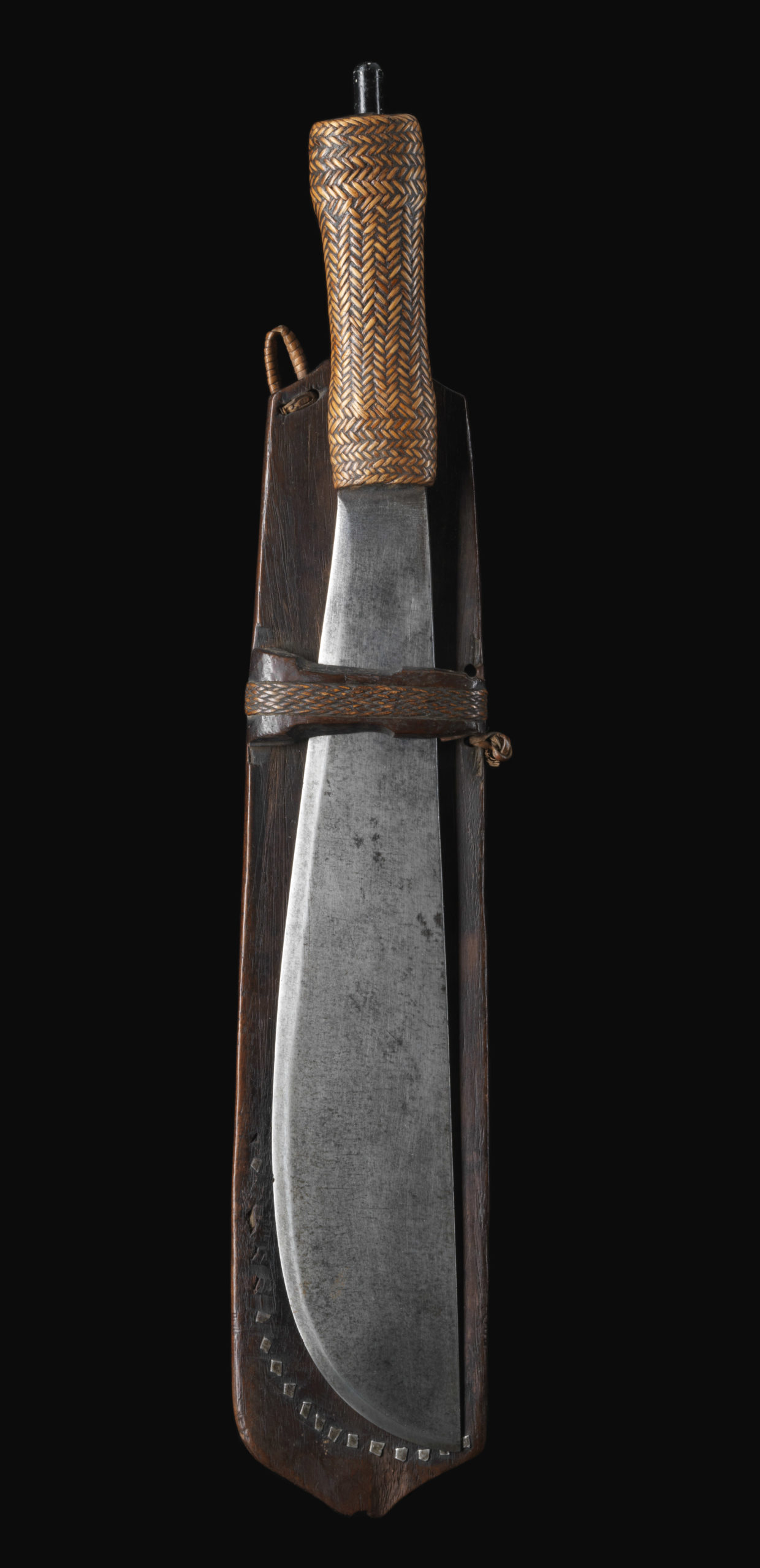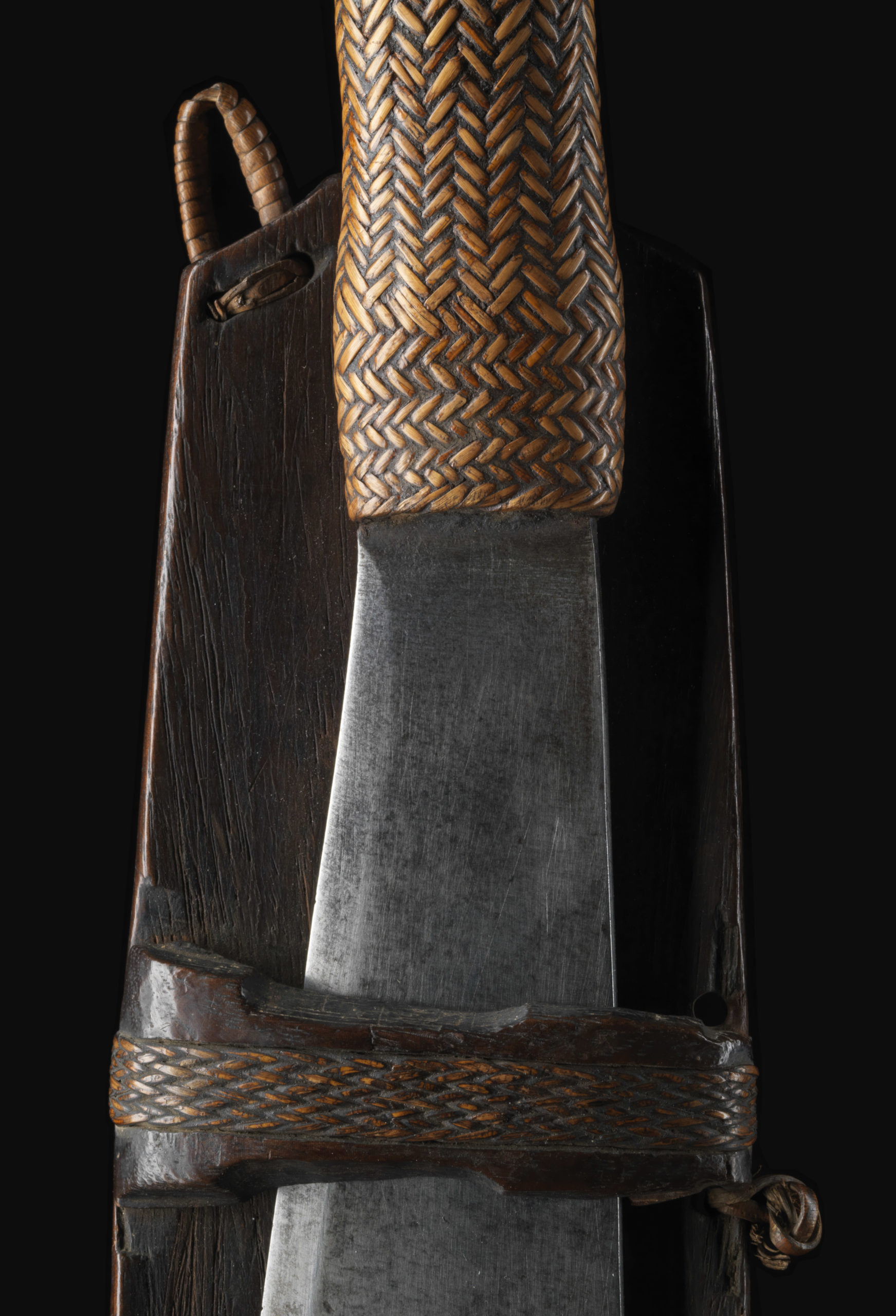Hand knife “bolo”
The most important hand blade of some Igorot strains is the bolo, sometimes also called pika. Bolo is a collective name for various long knives, tusks and short swords in the Philippines, similar to parang or klewang in Indonesia. Bolo is an unspecific, generic term for a variety of large-bladed knives or swords, like parang or klewang in Indonesia and Malaysia. The word has the same root as the Indo-Malayan baladau (or Niasian balato), although the Old Turk word pala (sword, sabre) was probably associated with the long-known Chinese dao, “knife” (meaning “sword knife” or “sabre knife”). Another possible but less likely derivation is from Sanskrit pada, pata (sword). Accordingly, there is a great variety of different types of blank weapons which are called by this name. One can clearly see that the constructional features, such as the grip sleeve forged integrally with the blade and covered with woven rattan bands, and the scabbard open on one side, called a hicot, are very similar to those of the Paiwan and Atayal swords on Formosa.
In the Igorot, bolo serve as universal working and fighting knives. Groups using the bolo include Ifugao, Bontoc, Ilongot, and Kalinga. The bolo of the Igorot can be single-edged or double-edged, but they all have in common a relatively heavy, front-loaded blade that is well suited for cutting. All bolo are universal tools. Their morphological relationship with blade objects from Taiwan Formosa is unmistakable; there is also a similarity with Japanese matagi-nagasa (hunting knives). The blade length of the bolo is between 30 cm and 50 cm, but can also vary upwards or downwards in individual cases. They can be very heavy and solid and, like axes, can be used for working on strong wood.
All Igorot work metal and make their weapons and tools themselves. Little is known whether iron or steel was smelted locally, but it can be assumed, since the old blades show a pronounced grain and specific forging texture with a welded steel edge, which does not suggest European or Chinese import. Some primary sources also contain images of early 20th century Igorot smiths, which are similar to those of Malay or Indonesian smiths: a small “pavilion” with the piston blower, a ground-level chimney and a stick anvil embedded in a swinging tree trunk or the ground.
Within the individual tribes, bolo differ only slightly from each other, with the exception of the bolo of the Ilongots, which is striking for its different blade and sheath shape, and is closer to the knives of the truku or lalau of the Atayal on North Formosa, while the “normal” bolo with a steel handle is similar to the knives of the takit or rinadrug of the paiwan groups.
The blade of a bolo is usually relatively heavy and strong. From the base the blade widens, with the cutting edge initially straight, then ending in an initially gentle, then increasingly narrow and finally semi-circular arc towards the point lying in the back line. The cutting edge is usually, but not always, clearly set off from the lateral surface. There are no hollow areas, so the cross-section of the full blade is pentagonal or wedge-shaped. The bolo is an indispensable everyday tool for all Igorot, in rural areas even today. This is why it was not included in the Americans’ ban on weapons after the Spanish-American war; it was too important as a utility tool. Even the GI’s liked to wear it. It should be noted that in all known photographed or drawn battle scenarios, the lance or the head axe are always the main weapons, never the bolo. It is first and foremost a tool.
Bolo can have two different grip types. The first type is known and used worldwide. It is based on the classic stick fishing rod, with which most types of bright weapons in the world are equipped (with the exception of the Balkan or Turkish metropolitan area, where the Bronze Age technique of the flat or rim fishing rod was retained). A perforated handle (always made of wood in the case of bolo) is pushed onto a forged tang, which is protected against splitting with metal clamps. It can be fixed with resin (gutta-percha) and (rarely) secured against slipping off with a rivet button at the end of the handle. The second variant, relatively rare in the world, consists of a pipe hinge (grommet handle) which functions as a handle and is forged in one piece with the blade. In principle, the blunt end of the blade is forged into a round or oval piece of pipe, which logically requires an oversize of this area of about 2.5 times the later diameter of the handle. At the transition between the flat blade and the round pipe rod, a trapezoidal constriction must be prepared during the forging process before the grip sleeve is “rolled up”. Rattan frets or complete wrappings then facilitate the handling of the weapon. If the rattan wrapping is in the form of a double cross-winding, the hand has a particularly good grip, even in the rain or a sweaty hand. It is possible that this technique goes back to the original function of (imported) blades as a lance tip, as it is possible to insert a shaft into the grommet. Contrary to the first impression that the layman craftsman might have, this is the more elaborate variant and requires forging experience and a certain range of tools, because with good bolo the spout edges meet in the butt (not overlapping) and therefore must be precisely dimensioned, not too thick (or too thin) and the blacksmith must have a good feeling for form and proportion overall.
The construction with iron socket handle and open scabbard seems to date back to the early Iron Age in South East Asia, otherwise the parallels can hardly be explained. These forms are “purely Austronesian” and predate the period of Indian cultural influence, which became decisive in the late first millennium. In terms of formal structure, the knives are also closely related to blade objects of the eastern Himalayas (Bhutan, pa-tag sword).
Just as there are two different types of handles, there are also two types of sheath: the open sheath and the closed sheath. Both differ in the way the weapon is covered when it is supplied.
The open scabbard consists of a small board, in which the outline of the bolo blade has been hollowed out. This is especially true for the lower part, the upper part is more deeply hollowed so that the blade can slide into the hollow from above in its entire width. The grip of the blade to the back, right and left is thus determined by the shape of the hollow in the board. A narrow web runs over the blade, which ensures the hold. This type of blade fitting, although very practical, is quite unusual worldwide. A rattan cord is usually attached to the bridge to which the suspension can be attached. The open sheath is the type used by the Ifugao. It is also known from Taiwan-Formosa and is quite rare worldwide; only the Naga in Myanmar and Bhutan (patag sword) use it as well. The closed scabbard corresponds in construction to the usual type of blade sheath in the Southeast Asian archipelago; it consists of two boards hollowed out on one side, which are placed on top of each other and joined together with two or more frets. Here too, the hollowing is adapted to the shape of the blade. The handle protrudes completely out of the sheath, the scabbard mouth is fitted with a cover plate. The bolo sheath of the Ilongot also belongs to the closed sheath type. This is made in the same way as the other closed bolo sheaths, but it looks completely different. While the shape of the sheath of the Ifugao, Bontok and Kalinga bolos sheaths is modelled on the blade shape, the sheath of the Ilongot bolos sheaths is decorated with a trapezoidal extension that goes back to a stylised snake’s head, as can be clearly seen on Formosa weapons. An interesting feature of the closed types is that many sheaths have a statuette carved in half relief from the upper plate. This can be an ancestor figure, a lizard or another lucky symbol.
This also corresponds to blade objects of Taiwan, especially the paiwan. The lizard is closely linked (as is the snake) to the mythology associated with headhunting and ritual warfare throughout the Austronesian region and is thought to have originated in the toned-down depiction of the mighty (Indian-Lebantian) crocodile, the most powerful inhabitant of the life-giving rivers and lord of life and death. There are also sheaths in which these figures are braided from rattan and connected by the straps.
| Object | Hand knife “bolo” |
| Culture | Philippinen, Igorot |
| Time | 19th century |
| Dimensions | Total length 46 cm, blade length 44 cm |
| Material | Steel, wood, rattan diamond-shaped metal inlays |





